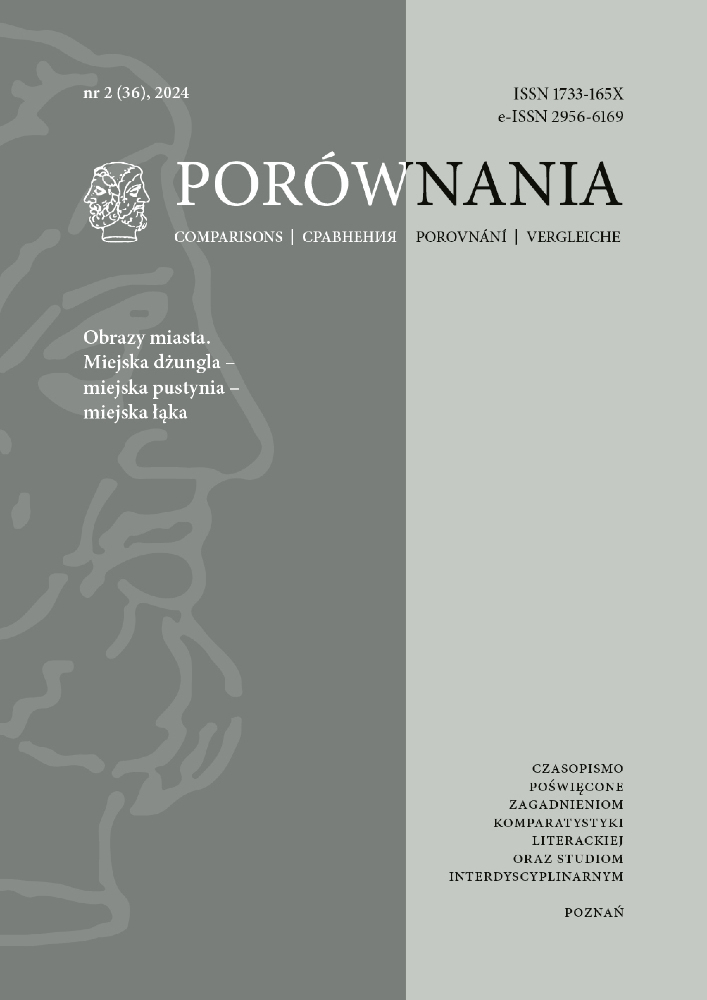Abstract
The subject of this text is the description of the evolution of photographers’ attitudes towards the city, expressed in images whose subject is both the material and human urban fabric. The chronological scope covers the period from the mid-nineteenth century to the turn of the 1960s and 1970s. The geographical scope includes Europe and the USA.
References
Annan Thomas (1900), The Old Closes and Streets of Glasgow, James MacLehose and Sons, Glasgow, https://tinyurl.com/2dcuvs6a [dostęp 20.02.2024]
Brand Bill (1938), A Night in London, Country Life, London – Arts et Métiers Graphiques, Paris – Charles Scribner’s Sons, New York.
Brassai (1933), Paris des Nuits, Arts et Métiers Graphiques, Paris.
Breton André (1928), Nadja, Librairie Gallimard, Éditions de la nouvelle revue française, Paris.
Bright Deborah (2013), Photographing Nature, Seeing Ourselves, w: America in View. Landscape Photography 1865 to Now, [kat. wyst.] Museum of Art, Rhode Island School of Design, Providence, September 21, 2012 – January 13, 2013, s. 30–51.
Choldin Harvey M. (2005), Chicago Housing Authority, w: The Electronic Encyclopedia of Chicago, https://tinyurl.com/4a625b7c [dostęp 18.02.2024]
Clark Catherine E. (2014), C’était Paris en 1970. Histoire visuelle, photographie amateur et urbanisme, „Études photographiques”, nr 31/2014, https://tinyurl.com/4jcjaavs [dostęp 07.03.2019]
Davidson Bruce (1970), East 100th Street, Harvard University Press, Cambridge.
Hamilton Peter (2001), «A poetry of the streets» Documenting Frenchness in an Era of Reconstruction: Humanist Photography 1935–1960, w: Norman Buford (red.), The Documentary Impulse in French Literature, Rodopi, Leiden, s. 177–229. DOI: https://doi.org/10.1163/9789004486171_015
Lechowicz Lech (2012), Historia fotografii, część 1, 1838–1939, Wydawnictwo PWSFTviT, Łódź.
Marinetti Filippo Tommaso (1909), Manifest założycielski i manifest futuryzmu, w: Artyści o sztuce. Od van Gogha do Picassa, wybrały i oprac. Elżbieta Grabska i Hanna Morawska, Państwowe Wydawnictwo Naukowe, Warszawa, s. 148–154.
Moholy-Nagy László (1927), Malerei Fotografie Film, Albert Langen Verlag, München; fragment tłum. pol.: L. Lechowicz, „Obscura”, nr 1–2 (1985), s. 35–36.
Riis Jacob A. (1890), How the Other Half Lives. Studies Among the Tenements of New York, Charles Scribner’s Sons, New York. DOI: https://doi.org/10.1037/12986-000
Rodczenko Aleksander (1988), Drogi współczesnej fotografii, „Obscura”, nr 8, s. 30–36.
Sant’elia Antonio (1914), Architektura futurystyczna, w: Christa Baumgarth, Futuryzm, tłum. Jerzy Tasarski, Wydawnictwa Artystyczne i Filmowe, Warszawa, s. 309.
Sommer Karl (1929), Film und Foto. Ausstellung des Deutschen Werkbund, „Essener Algemeinen Zeitung”, 26.05.1929; cyt. za: Herbert Molderings, Drugie odkrycie fotografii, „Obscura”, nr 6/1983, s. 2–29.
Thomson John (1877), Street Life in London, Sampson Low, Marston, Searle & Rivington, London.
Victor Frederick (2024), Terrible Living Conditions inside the Squalid New York City’s Tenements in the Late 19th Century, https://tinyurl.com/58ty8eyh [dostęp 25.03.2024]
Weegee (1945), Naked City, Essential Books, New York.
Windish Hans (1928), Vorwort 1928/29, w: Das Deutsche Lichtblid Jahres 1928–1929, Verlag Robert&Bruno Schultz, Berlin, s. nlb.
License
Copyright (c) 2024 Lech Lechowicz

This work is licensed under a Creative Commons Attribution-NoDerivatives 4.0 International License.
Utwory opublikowane w czasopiśmie „Porównania”, na platformie Pressto należącej do Uniwersytetu im. Adama Mickiewicza w Poznaniu są udostępniane na licencji Creative Commons Uznanie autorstwa - Bez utworów zależnych 4.0 Międzynarodowe (CC BY-ND 4.0)
Tym samym wszyscy zainteresowani są uprawnieni do korzystania z utworów opublikowanych pod następującymi warunkami:
-
uznania autorstwa — czyli obowiązek podania wraz z rozpowszechnianym utworem informacji o autorstwie, tytule, źródle (odnośniki do oryginalnego utworu, doi) oraz samej licencji
-
bez utworów zależnych — remiksując, przetwarzając lub tworząc na podstawie utworu, nie wolno rozpowszechniać zmodyfikowanych treści.
-
brak dodatkowych ograniczeń — nie można korzystać ze środków prawnych lub technologicznych, które ograniczają innych w korzystaniu z utworu na warunkach określonych w licencji.
Uniwersytet im. Adama Mickiewicza w Poznaniu zachowuje prawo do czasopisma jako całości (układ, forma graficzna, tytuł, projekt okładki, logo itp.).
Autor zachowuje prawa majątkowe, ale udziela zgody Uniwersytetowi im. Adama Mickiewicza w Poznaniu na wykorzystanie dzieła. Autorzy tekstów zakwalifikowanych do publikacji proszeni są o wypełnienie podpisanie i przesłanie umowa (PL) agreement (EN)
Agreement for granting a royalty-free license to works with a commitment to grant a CC sub-license





